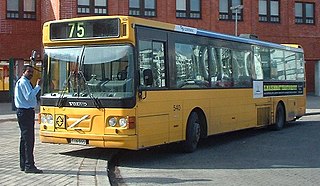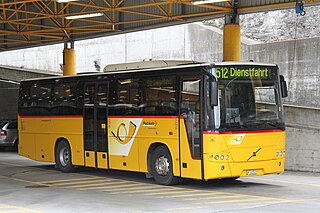The Volvo B10 was a front-engined bus chassis built in the 1930s, but may also refer to different 9.6-litre engined bus chassis from Volvo Buses:

The Volvo B10 was a front-engined bus chassis built by Volvo in the 1930s.

A bus is a road vehicle designed to carry many passengers. Buses can have a capacity as high as 300 passengers. The most common type of bus is the single-deck rigid bus, with larger loads carried by double-decker and articulated buses, and smaller loads carried by midibuses and minibuses; coaches are used for longer-distance services. Many types of buses, such as city transit buses and inter-city coaches, charge a fare. Other types, such as elementary or secondary school buses or shuttle buses within a post-secondary education campus do not charge a fare. In many jurisdictions, bus drivers require a special licence above and beyond a regular driver's licence.

A chassis is the framework of an artificial object, which supports the object in its construction and use. An example of a chassis is a vehicle frame, the underpart of a motor vehicle, on which the body is mounted; if the running gear such as wheels and transmission, and sometimes even the driver's seat, are included, then the assembly is described as a rolling chassis.
- Volvo B10B, a rear-engined bus and coach chassis
- Volvo B10BLE, a low-entry single-decker city bus chassis developed from the B10B
- Volvo B10C, a tri-axle coach chassis based on the B10M, only for the Australian market
- Volvo B10L, a low-floor rear-engined single-decker city bus
- Volvo B10LA, articulated version of the B10L
- Volvo B10M, a versatile mid-engined single-decker bus and coach chassis
- Volvo B10MA, articulated version of the B10M
- Volvo B10MD, double-decker version of the B10M
- Volvo B10R, a rear-engined bus chassis
- Volvo B10TL (Super Olympian), a low-floor rear-engined tri-axled double-decker bus chassis
- Volvo C10M, a coach chassis based on the B10M

The Volvo B10B was a rear-engined step deck single-decker bus chassis manufactured by Volvo between 1992 and 2001. The first prototype were built in 1990, but the B10B wasn't launched until the 1992 Geneva Motor Show. It superseded the Leyland Lynx and Volvo B10R. For stage use it was gradually succeeded by the low-entry B10BLE, which was introduced only a year later, though not in all markets. For interurban use the B7R came as a gradual replacement in 1998, and ultimately for coach work, the B12B took over in 2001.

The Volvo B10BLE was a low-entry single-decker bus chassis manufactured by Volvo in Sweden between 1993 and 2004. The first prototypes were built in 1992, but mass production started in 1993, only a year after the high-floor B10B. It was popular in Australia, Scandinavia and the United Kingdom. It had the engine mounted on the rear overhang of the bus. It became the successor of the city bus version of the B10B and was used as a base for single-decker buses worldwide. The B10BLE was available in diesel powered format, and later in a compressed natural gas powered format with the fuel tanks on the roof of the bus. Its low-floor design was widely promoted by Volvo when it was first launched, on the basis of added convenience to the passengers, and the increase in transport efficiency due to the low-floor design.
The Volvo B10C was a coach chassis manufactured by Volvo between 1988 and 1991. It was developed as a 3-axle version of the Volvo B10M specifically for the Australian market and came with a raked front. It sold in small numbers with purchasers including the Australian Army, Bus Australia and Peninsula Bus Lines.
| This disambiguation page lists articles associated with the title Volvo B10. If an internal link led you here, you may wish to change the link to point directly to the intended article. |

















